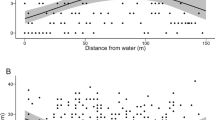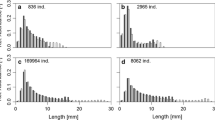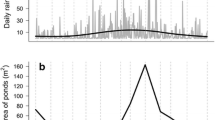Summary
Cyprid larvae of Balanus cariosus settle preferentially on slate plates with a biota characteristic of the lower intertidal shore, and the cyprids also prefer plates with more algae. Cyprid larvae of Balanus glandula had the same preferences in two out of three experiments. We conclude that some component of the flora guides both species during settling and metamorphosis. Data on vertical distribution and fecundity of B. glandula show that the preference for the lower shore decreases fitness of B. glandula at the site of the settling experiments and at most other sites sampled in or near the San Juan Islands, though in some restricted habitats in the San Juans and extensive areas in the adjacent regions of Puget Sound a preference for the lower shore is appropriate. Extensive dispersal among sites is possible in the planktonic period of 2 to 4 weeks. This example supports the hypothesis that a cost to large scale dispersal is lower fitness at many sites within a species' range. In this case the cost is through poorer correlation between stimuli guiding choice of habitat and favorability of habitat.
Similar content being viewed by others
References
Ament AS (1979) Geographic variation in relation to life history in three species of the marine gastropod genus Crepidula: Growth rates of newly hatched larvae and juveniles. In: S Stancyk (ed), Reproductive Ecology of Marine Invertebrates. Univ. of South Carolina Press, Columbia, South Carolina, p 61–76
Barnes CA, Ebbesmeyer CC (1978) Some aspects of Puget Sound's circulation and water properties. In: B Kjerfve (ed) Estuarine Transport processes. University of South Carolina Press, Columbia, S C, p 209–228
Berger EM (1973) Gene-enzyme variation in three sympatric species of Littorina. Biol Bull 145:83–90
Cannon GA, ed. (1978) Circulation in the Strait of Juan de Fuca. National Oceanic Atmospheric Admin. Tech Rept ERL 399-PMEL 29 p 49
Connell J (1970) A predator-prey system in the marine intertidal region. I. Balanus glandula and several predatory species of Thais. Ecol Monogr 40:49–78
Dayton PK (1971) Competition, disturbance, and community organization: the provision and subsequent utilization of space in a rocky intertidal community. Ecol Monogr 41:351–389
Doyle RW (1974) Choosing between darkness and light: the ecological genetics of photo behaviour in the planktonic larva of Spirorbis borealis. Mar Bio 25:311–317
Doyle RW (1975) Settlement of planktonic larvae: a theory of habitat selection in varying environments. Amer Nat 109:113–126
Ebbesmeyer CC, Helseth JM, Cox JM (1977) Surface drifter movements observed in outer Strait of Juan de Fuca, July, 1977. National Oceanic and Atmospheric Admin Tech Mem ERL MESA-22, p 70
Grassle JF, Grassle JP (1978) Life histories and genetic variation in marine invertebrates. In: B Bataglia and JA Beardmore (eds), Marine Organisms Genetics, Ecology and Evolution. Plenum New York, p 347–364
Hines AH (1978) Reproduction in three species of intertidal barnacles from central California. Biol Bull 154:262–281
Hines AH (1979) The comparative reproduction ecology of three species of intertidal barnacles. In: S Stancyk (ed) Reproductive Ecology of Marine Invertebrates. Univ. of South Carolina Press, Columbia, South Carolina, p 213–234
Mackay TFC, Doyle RW (1978) An ecological and genetic analysis of the settling behaviour of a marine polychaete: 1. Probability of settlement and gregartious behaviour, Heredity 40:1–12
Mileikovsky SA (1971) Types of larval development in marine bottom invertebrates. Their distribution and ecological significance: a reevaluation. Mar Biol 10:193–213
Moyse J, Knight-Jones EW (1967) Biology of cirripede larvae. In: Symp. Crustacea Proc. Ernakulam, 1965. Mar Biol Ass India, Bangalore Press, Bangalore, p 595–611
Pashinski DJ, Charnell RL (1979) Recovery record for surface drift cards released in Puget Sound — Strait of Juan de Fuca system during calendar years 1976–77. National Oceanic and Atmospheric Admin Tech Man ERL PMEL-14, p 30
Rice LA (1935) Factors controlling arrangement of barnacle species in tidal communities. Ecol Monogr 5:293–304
Scheltema RS (1977) Dispersal of marine invertebrate organisms: paleobiogeographic and biostratigraphic implications. In: EG Kauffman, JE Hazel (eds) Concepts and Methods of Biostratigraphy. Dowden, Hutchinson & Ross, Inc., Stroudsburg, Pennsylvania, p 73–108
Strathmann RR (1974) The spread of sibling larvae of sedentary marine invertebrates. Amer Natur 108:29–44
Strathmann RR, Branscomb ES (1979) Adequacy of cues to favorable sites used by settling larvae of two intertidal barnacles. In: SE Stancyk (ed) Reproductive Ecology of Marine Invertebrates. Univ. South Carolina Press, Columbia, S.C., p 77–89
Waldichuk M (1958) Drift bottle observations in the Strait of Georgia, J Fish Res Bd, Canada 15:1065–1102
Williamson DI (1967) Some recent advances and outstanding problems in the study of larval Crustacea. In: Symp. Crustacea Proc., Ernakulam, 1965. Mar Biol Ass India, Bangalore Press, Bangalore, p 815–823
Wu RSS (1980) Effects of crowding on the energetics of the barnacle Balanus glandula Darwin, Canadian J Zool 58:599–566
Wu RSS, Levings CD (1978) An energy budget for individual barnacles (Balanus glandula). Mar. Biol 45:225–235
Wu RSS, Levings CD, Randall DJ (1977) Differences in energy partition between crowded and uncrowded individual barnacles (Balanus glandula Darwin). Canadian J Zool 55:643–647
Author information
Authors and Affiliations
Rights and permissions
About this article
Cite this article
Strathmann, R.R., Branscomb, E.S. & Vedder, K. Fatal errors in set as a cost of dispersal and the influence of intertidal flora on set of barnacles. Oecologia 48, 13–18 (1981). https://doi.org/10.1007/BF00346982
Received:
Issue Date:
DOI: https://doi.org/10.1007/BF00346982




